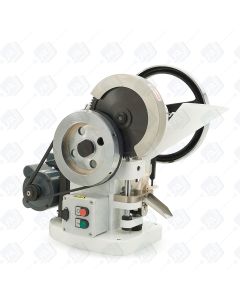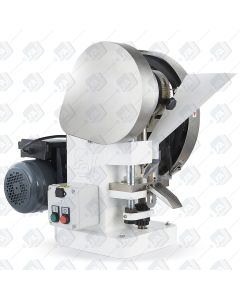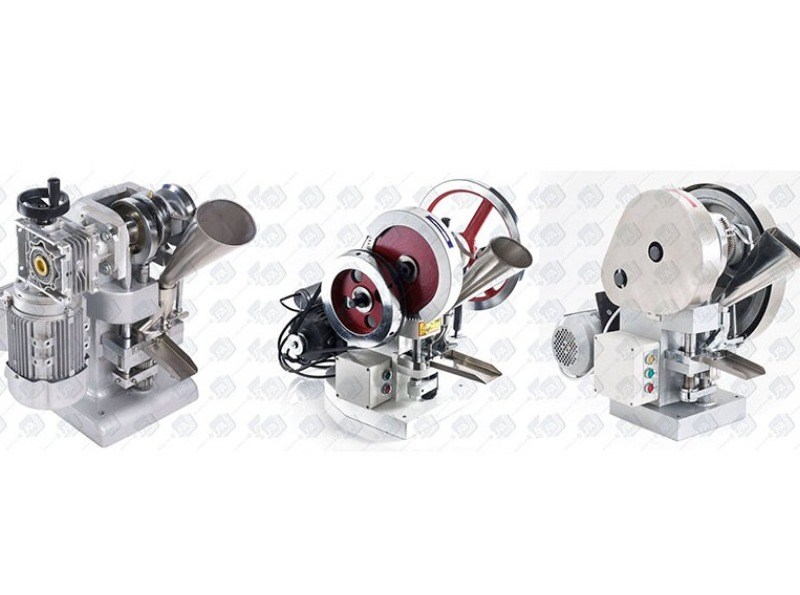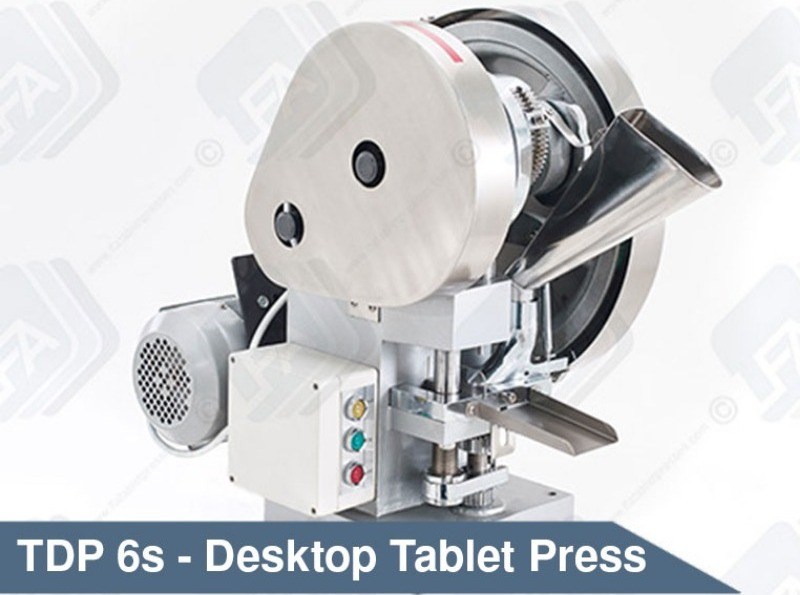This is a frequently asked question on the TDP range. This range of single station pill press includes the TDP 1.5, TDP 5 and TDP 6s. The machines are very similar and the main distinction between them is the pressure that is exerted during tablet making.
What is a single station tablet press and how does it work?
A single station tablet press is a simple mechanical machine that can be used to compress powder into tablets that are uniform in size, shape and weight. The machine is used for low-volume production of tablets for a wide range of applications from cosmetics and pharmaceuticals to cleaning products. Unlike larger industrial machines, a single station table press is useful for production of relatively low-volumes of basic shaped tablets. It is therefore well suited to R&D departments that need to produce small batches of new materials, or compounding pharmacists that need to test new formulations, or suppliers of nutraceuticals, supplements or herbal remedies that require a low-cost method of producing relatively small batches of products. This type of tablet press is used for a wide variety of applications on account of the low cost and versatility. Single station tablet presses are also used, for example, in the production of industrial catalysts for the petrochemical industries.
Operation of the single station tablet machine
In this type of press, tablets are made by compressing powders in a single die, with a punch or stamp. The formulation of powder is entirely governed by the intended application. Pharmaceuticals, for example employ a mixture of ingredients for the powder – the active ingredient (API), one or more inert excipients, lubricants and disintegrators, for example. The machine may be hand operated or it may be motorised. In the former case, tablets are made one at a time; in the latter case tablets can be made at in small production runs typically at a rate of 5000 tablets per hour. A typical single station press commonly features the following basic components:
- A Hopper – this holds the granules that need to be compressed. Powdered material falls by gravity from the hopper into the die.
- The die – this provides the mould that gives the compressed material the desired shape form. The base of the die is formed by the lower punch and it is the upper punch that descends onto the loose powder and compresses it.
- Upper and lower punches – the upper punch provides the compressive force to bind the powder granules into a tablet. The lower punch acts as a base for the die and is raised at the end of the compression phase to eject the tablet from the die.
- Cam track – this is the mechanical gear that guides the movements of the two punches
- Capacity Regulator – this regulates the depth of loose powder in the die by adjusting the depth of the lower punch
- Ejection regulator – regulates the lower punch so that when it is raised at the end of the compression, the punch is level with the surface of the die, enabling the finished tablet to be swept aside into the collecting vessel
- Driving wheel – guides the movement of the upper and lower punches and hopper shoe
Note that in a single station tablet machine there is only one upper and lower punch and die set. Force for compressing the tablet is exerted only through the upper punch, while the lower punch is stationary for the period of compression The powder material compacted by the pressure exerted between the moving upper punch and the lower stationary punch. The shape of the tablet is governed by the shape of the die cavity.
A single press produces tablets through a number of steps that can be described as follows:
Filling
Stage 1 – the upper cam withdraws the upper punch from the die, the bottom punch is low inside the die cavity so that the powder falls from the hopper and fills the cavity made by the die and bottom punch.
Stage 2 – the bottom punch is then adjusted to the required weight of material and, as it lifts, excess powder is ejected from the die.
Compression
Stage 3 – the lower punch remains stationary and the upper punch lowers into the die to compress the powder into a tablet.
Ejection
Stage 4 – the upper punch is then withdrawn while the lower punch pushes upwards lifting the formed tablet from the die. The tablet is then removed from the die surface by the surface plate.
Stage 5 – the cycle is then repeated for the next batch.
The machine is adjusted to suit the type of tablet, the material, compression and capacity of material required for each tablet. Adjustments are usually made by operating the machine manually so that a check can be made on the appearance, size and mechanical robustness of the formed tablets. Once the operator is satisfied with the quality of the tablet, the mechanical adjustments are locked into place, and the machine is ready for automatic production. It is important that settings are checked regularly especially if large quantities of tablets are made, to maintain the quality and standard of the product.
ニュースレターを購読
Advantages of the single station tablet press
(note that manual pill presses are also available)
- Compact and lightweight (some benchtop models are available), durable, operator friendly
- Designed for pressing a wide variety of granular materials – used for compressing a variety of round pharmaceutical tablets that contain different excipients
- Versatile unit that can be adjusted, hand operated or motor driven.
- One punch and die set is included when a press is purchased, the tool set can be adjusted to give required punch pressure, fill depth and table thickness
- The single station press is the most popular type of tablet press, but needs a high level of attention by the operator
- Advanced machine with new technology providing continuous control over loading of materials and table thickness
- Can be used for batch or manual production
- Comparable functions to other imported large-scale manufacturing machines
- Can be used for a wide variety of products in tablet form,
- e.g., chewable tablets containing mnnitol and lubricants
- effervescent tablets containing bicarbonates, and tartaric or citric acids,
- traditional pharmaceutical druges conaining diluents, lubricants and disintegrants
Maintenance and precautionary measures
- Before using the machine for the first time, the operator should read the instruction manual thoroughly
- As with any mechanical machine, regular servicing especially lubrication of certain parts of the machine will prolong the service life of the equipment.
- Lubricant should be added as recommended by the manufacturer, only to the oil cups or oil holes and friction surfaces.
- The machine should be emptied first before performing lubrication.
- Add the minimum of lubricant as recommended by the manufacturer will prevent any spillover that may cause contamination of products
- The machine should only be used in one direction, i.e,, the driving wheel should only be turned in the correct direction as indicated
- Belt adjustment (with the 2 screws) and other adjustments should be made carefully to avoid jarring or binding of mechanical parts
- During adjustment, fine-tuning is important. Adjusting the belt should be done through the two screws.
- When turning on the electricity to the machine, it is important that the upper punch is in its highest position to avoid any chance of breakage
Single Punch Machines Available from LFA
TDP 0 Benchtop Model Single Punch Tablet Press
- The TDP 0 Pill press is the smallest in our range
- Semi-portable, bench top unit
- Manual operation only
TDP 1.5 Benchtop Model Single Punch Tablet Press
- The TDP 1.5 is the first automatic in the TDP range
- Semi-portable, bench top unit
- Adjustable tablet thickness, punch pressure and fill depth
- One punch and die set included
- The TDP 1.5 is heavier than the TDP 0 Benchtop Press
TDP 5 Benchtop Model Single Punch Tablet Press
- The TDP 5 tablet press is the most popular in our range.
- Produces tablets of up to 20 mm in diameter
- Heavy duty bench top machine
TDP 6s Benchtop Model Single Punch Tablet Press
- The TDP 6s (replaced the TDP 7) exerts the most pressure
- Extra heavy unit that can produce up to 24mm diameter tablets
- Smooth operation, low level noise
- Precision filling, low consumption of materials
- Reliable, efficient (often use for R & D, in hospitals, labs, and small industrial companies).









